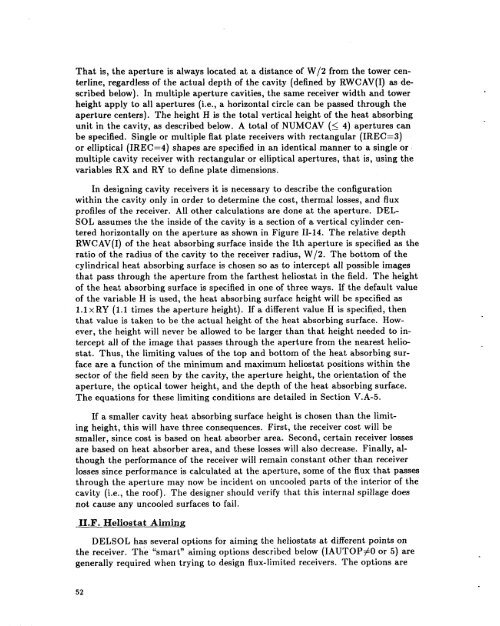A User's Manual for DELSOL3 - prod.sandia.gov - Sandia National ...
A User's Manual for DELSOL3 - prod.sandia.gov - Sandia National ...
A User's Manual for DELSOL3 - prod.sandia.gov - Sandia National ...
Create successful ePaper yourself
Turn your PDF publications into a flip-book with our unique Google optimized e-Paper software.
That is, the aperture is always located at a distance of W/2 from the tower cen-<br />
terline, regardless of the actual depth of the cavity (defined by RWCAV(1) as de-<br />
scribed below). In multiple aperture cavities, the same receiver width and tower<br />
height apply to all apertures (i.e., a horizontal circle can be passed through the<br />
aperture centers). The height H is the total vertical height of the heat absorbing<br />
unit in the cavity, as described below. A total of NUMCAV (5 4) apertures can<br />
be specified. Single or multiple flat plate receivers with rectangular (IREC=3)<br />
or elliptical (IREC=4) shapes are specified in an identical manner to a single or<br />
multiple cavity receiver with rectangular or elliptical apertures, that is, using the<br />
variables RX and RY to define plate dimensions.<br />
In designing cavity receivers it is necessary to describe the configuration<br />
within the cavity only in order to determine the cost, thermal losses, and flux<br />
profiles of the receiver. All other calculations are done at the aperture. DEL-<br />
SOL assumes the the inside of the cavity is a section of a vertical cylinder cen-<br />
tered horizontally on the aperture as shown in Figure 11-14. The relative depth<br />
RWCAV(1) of the heat absorbing surface inside the Ith aperture is specified as the<br />
ratio of the radius of the cavity to the receiver radius, W/2. The bottom of the<br />
cylindrical heat absorbing surface is chosen so as to intercept all possible images<br />
that pass through the aperture from the farthest heliostat in the field. The height<br />
of the heat absorbing surface is specified in one of three ways. If the default value<br />
of the variable H is used, the heat absorbing surface height will be specified as<br />
1.lxRY (1.1 times the aperture height). If a different value H is specified, then<br />
that value is taken to be the actual height of the heat absorbing surface. How-<br />
ever, the height will never be allowed to be larger than that height needed to in-<br />
tercept all of the image that passes through the aperture from the nearest helio-<br />
stat. Thus, the limiting values of the top and bottom of the heat absorbing sur-<br />
face are a function of the minimum and maximum heliostat positions within the<br />
sector of the field seen by the cavity, the aperture height, the orientation of the<br />
aperture, the optical tower height, and the depth of the heat absorbing surface.<br />
The equations <strong>for</strong> these limiting conditions are detailed in Section V.A-5.<br />
If a smaller cavity heat absorbing surface height is chosen than the limit-<br />
ing height, this will have three consequences. First, the receiver cost will be<br />
smaller, since cost is based on heat absorber area. Second, certain receiver losses<br />
are based on heat absorber area, and these losses will also decrease. Finally, al-<br />
though the per<strong>for</strong>mance of the receiver will remain constant other than receiver<br />
losses since per<strong>for</strong>mance is calculated at the aperture, some of the flux that passes<br />
through the aperture may now be incident on uncooled parts of the interior of the<br />
cavity (Le., the roof). The designer should verify that this internal spillage does<br />
not cause any uncooled surfaces to fail.<br />
1I.F. Heliostat Aiming<br />
DELSOL has several options <strong>for</strong> aiming the heliostats at different points on<br />
the receiver. The “smart” aiming options described below (IAUTOP#O or 5) are<br />
generally required when trying to design flux-limited receivers. The options are<br />
52

















